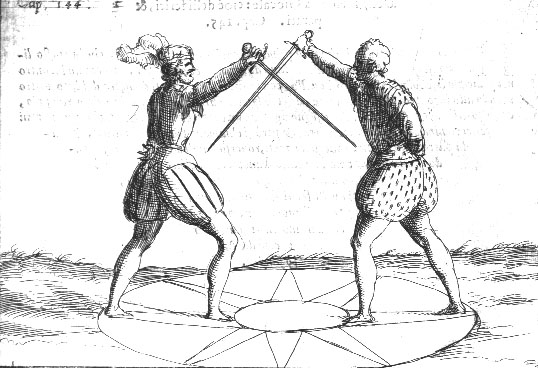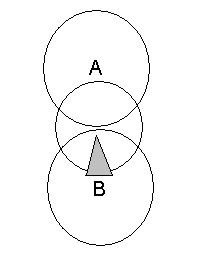Italian Circle
Like the Spanish system of Fence the Italian system(s) also used a circular concept
of combat. As early as Marozzo this circular system was being developed. To quote
from Marozzo Cap. 144 
"This is the segno, where you'll make your students walk, stepping forward
as well as back, with weapons in hand, round about, putting their feet on the
edges that cross the segni tondi (round signs)."
There are three principles that guide all combat in the Italian system.
1) Principle of Expansion/contraction
2) Principle of Angulation
3) Principle of the hand & foot.
Along with the principles are three distances
1) Normal – with swords extended the tip of the sword is at your opponent's
guard
2) Close – With arms extended the guards are together
3) Grappling distance – Hand is inside the inside of the opponent's
guard. (Giocco stretto)
The principle of expansion/contraction is that for all attacks you must expand
out towards your opponent. Marozzo used the gran passo or great step when making
the attack. Later masters such as Fabris taught the lunge. When defending you
close the line you are being attacked in. This closing of the line may be considered
a contraction. However in 16th century swordplay the arm is not withdrawn in
the parry as say done in some schools of modern fence such as the French school
for foil.
The principle of angulation states that you will use angle of blade
to attack your opponent. Geometry is very important in the Italian system.
Opposition is important when dealing with angulation. Opposition may be
used on the attack or in defense to take your opponent's point away from
you.
The principle of the hand & foot states that the hand and foot must
finish movement at the same time on attacks. As the thrust or cut lands
the moving foot must land at the same time.
The normal distance is the safe distance where you attack and defend.
At normal distance you may also make attacks on advanced targets such as
the hand. Close distance is the hot distance where you may wound your opponent.
So, at this distance you may strike your opponent's head or torso.
 Like the Spanish
system the Italian System uses circles to help visualize attack, defense
and movement. Unlike the Spanish system the Italian system uses three circles.
Each fencer has a circle that they stand in the center of. A third circle
lies between the two fencers. During an attack the attacking fencer must
take the center circle. To do so he will move on an angle across his own
circle while forcing his opponent's blade to the circumference of the middle
circle. The defender will also move on an angle across their own circle.
The attacker obtains the "triangle" of attack to successfully land a touch
on their opponent.
Like the Spanish
system the Italian System uses circles to help visualize attack, defense
and movement. Unlike the Spanish system the Italian system uses three circles.
Each fencer has a circle that they stand in the center of. A third circle
lies between the two fencers. During an attack the attacking fencer must
take the center circle. To do so he will move on an angle across his own
circle while forcing his opponent's blade to the circumference of the middle
circle. The defender will also move on an angle across their own circle.
The attacker obtains the "triangle" of attack to successfully land a touch
on their opponent.
Ideas for this circular theory of fencing were initially introduced to me by
IMAF instructors circa 2000 or 2001.
 Like the Spanish
system the Italian System uses circles to help visualize attack, defense
and movement. Unlike the Spanish system the Italian system uses three circles.
Each fencer has a circle that they stand in the center of. A third circle
lies between the two fencers. During an attack the attacking fencer must
take the center circle. To do so he will move on an angle across his own
circle while forcing his opponent's blade to the circumference of the middle
circle. The defender will also move on an angle across their own circle.
The attacker obtains the "triangle" of attack to successfully land a touch
on their opponent.
Like the Spanish
system the Italian System uses circles to help visualize attack, defense
and movement. Unlike the Spanish system the Italian system uses three circles.
Each fencer has a circle that they stand in the center of. A third circle
lies between the two fencers. During an attack the attacking fencer must
take the center circle. To do so he will move on an angle across his own
circle while forcing his opponent's blade to the circumference of the middle
circle. The defender will also move on an angle across their own circle.
The attacker obtains the "triangle" of attack to successfully land a touch
on their opponent.
